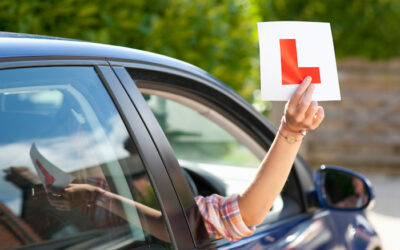If you know what to look for, you should be able to tell the speed limit of any road in the UK.
Let’s take a look at some of the common signs to look out for. If you are a learner driver you will come across these when you learn the highway code.

How to know if a road is National Speed Limit: The NSL Rule
NSL stands for “National Speed Limit.” It also stands for “No Street Lights.” As a general rule of thumb, NSL = NSL. No Street Lights = National Speed Limit.So when you’re driving on UK roads, if you see No Street Lights (NSL) then the National Speed Limit Applies. Unless, of course, the road signs say otherwise.
If you see street lights, then you can usually assume that the speed limit on that road is 30 mph. But again, be on the lookout for road signs that might say otherwise.
What’s the National Speed Limit?
It depends on the type of car you’re driving and the type of road you’re driving on – whether it’s a built-up area, a single carriageway, a dual carriageway, or a motorway. There’s a handy table on the government’s site that explains the various National Speed Limits that apply to different roads and vehicles.
Road Signs
Road signs give the clearest indicator of what the speed limit is on any UK road. They override the NSL=NSL rule. So whether there are street lights or not, you should always be on the lookout for speed limit road signs.
There are two main types of speed limit signs:
Gateway road signs
These appear on both sides of the carriageway, so you’ll often find them at junctions where roads begin. They’re big round signs, so they’re hard to miss.
Repeater road signs
These are smaller signs that alternate between the left and right of the carriageway. Having passed through the gateway signs, these serve to remind you of the speed limit as you proceed down the road.
Some speed limit signs contain a red circle and a black number on a white background. This means that the sign’s giving you a direct order. The speed limit’s not advisory, it’s the law!
Also look out for a white circle with a black diagonal band going from the top right to the bottom left. This sign means that the National Speed Limit applies. And once more, this will vary depending on the vehicle and the type of road. So be sure to learn the rules for your vehicle!
Types of Speed Limit Signs
There are three other types of speed limit signs:
Roadworks signs
Sometimes there might be a temporary speed limit due to roadworks. Look out for temporary signs – they should appear some distance before the actual roadworks, to give you plenty of time to slow down if necessary.
Advisory signs
You’ll often find these near schools and other public buildings. They might say something like “20 mph when flashing lights show”. Needless to say, if the lights are flashing, then you should drop your speed immediately. But even if the lights aren’t flashing, it might be a good idea to slow down anyway. You never know – the lights might be broken, and there could be hazards ahead!
Gantry signs
Look out for the illuminated signs on the gantries above motorways, as these will give you up-to-date information on any temporary speed restrictions that might apply due to accidents or roadworks. Once you see one of these signs, consider it to be the speed limit until you learn otherwise. The gantries should also make it clear once these temporary restrictions no longer apply. They’ll either display the standard National Speed Limit sign (the white circle with the black diagonal stripe), or they’ll explicitly say something like “End of temporary restrictions.”
Painted signs
Sometimes you might see a sign painted directly on the road. There are a few reasons why local councils might paint speed limits on roads. In most cases, it’s because they want all motorists to be absolutely sure of a road’s speed limit. This might simply mean that a stubborn tree kept obscuring the speed limit sign on the side of the carriageway. Or it might mean that there’s a hazard ahead – such as a blind junction or a school – and the council really wants you to slow down.
Sat Navs and Smart Phones Speed Limit
Some sat navs and smart phones will display the speed limit of whichever road you’re driving on. Some will even flash a warning if they detect you’re breaking the limit.
This is a very useful feature, but you shouldn’t depend on it. Why? Three reasons:
- The system software might be out of date, so it might not account for changes in local laws. Also, there might be some delay when you’re moving from one road to another. You could move from a road with a 60mph limit to a road with a 40mph limit, but your sat nav might not tell you about the change until it’s too late.
- Your smart phone and sat nav will not know about temporary speed limits due to roadworks, and it’s very unlikely to know about advisory speed limit around schools and other buildings.
- It’s generally not a good idea to spend too much time looking at your smartphone or sat-nav while driving. You should focus almost all of your attention on the road. If you rely too much on your device for speed limit updates, you could get distracted. And that’s how accidents happen.
Speed Limits Are There for a Reason
The speed limit on every road in the UK is there to keep road users and pedestrians as safe as possible at all times. There are severe penalties for speeding, so you should never ignore any speed limit signs.
And no matter what the road’s speed limit is, remember Rule 126 of the Highway Code: Drive at a speed that will allow you to stop well within the distance you see to be clear.
So long as you commit to careful and conscientious driving, you should be fine. Unfortunately, even if you’re the safest driver in the world, there’s no accounting for other drivers. That’s why it pays to have comprehensive car insurance, so that you’ll be covered no matter what happens on the roads.



